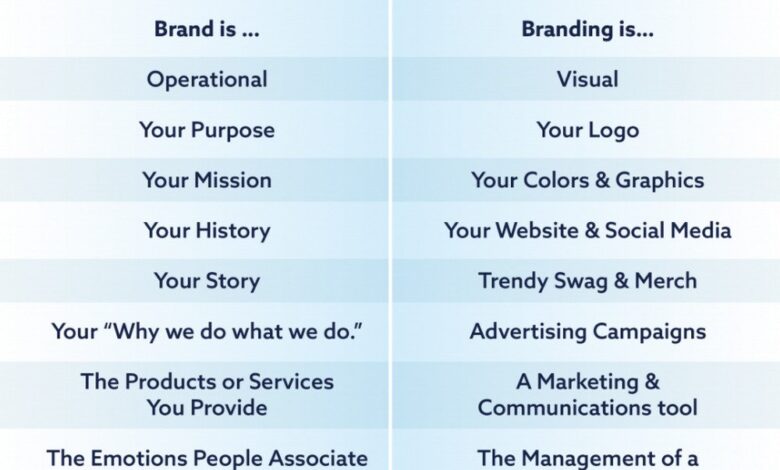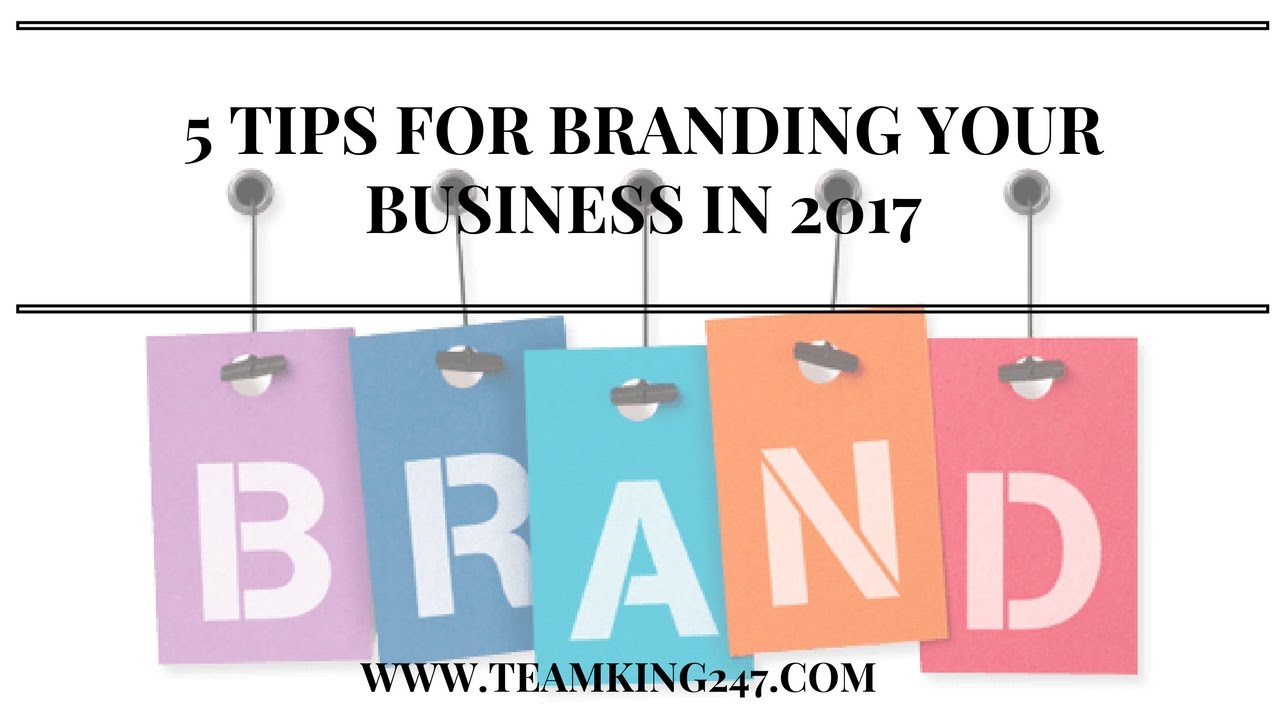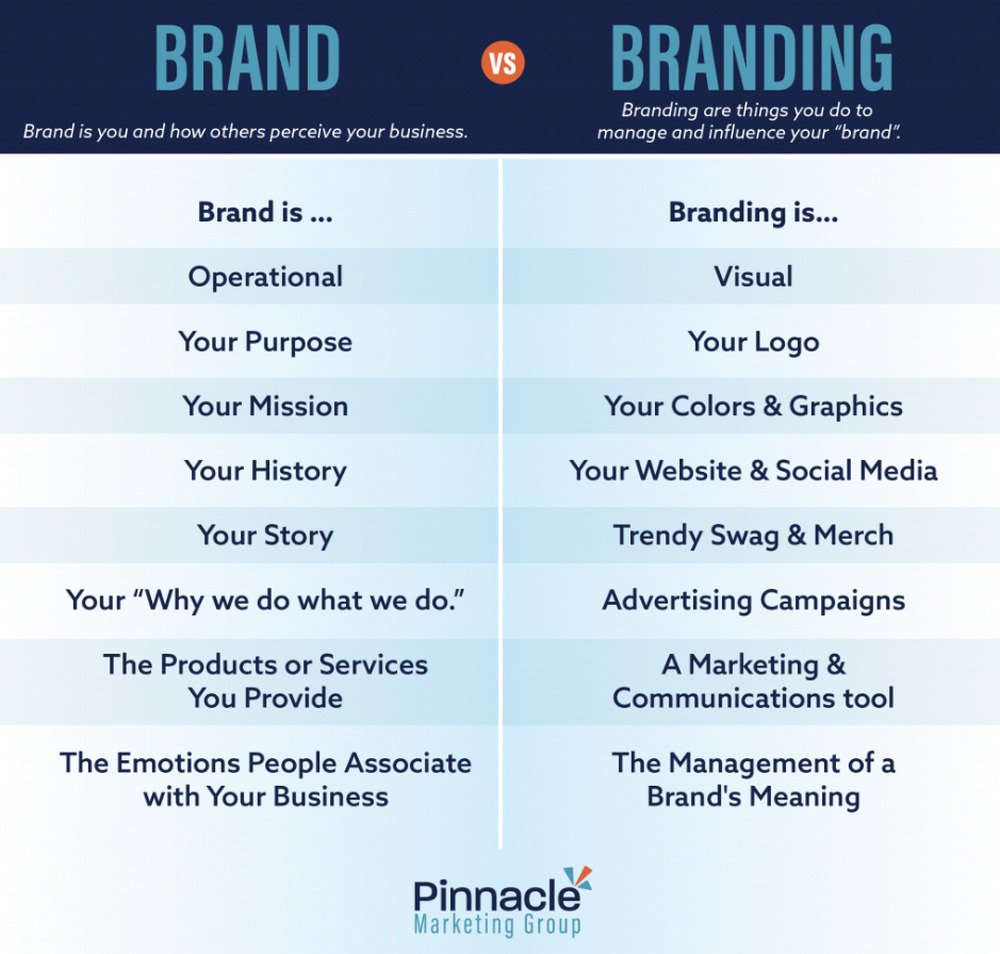
How Branding Transforms Your Business
How branding transforms your business is a question every entrepreneur grapples with. It’s not just about a logo; it’s the heart and soul of your company, the story you tell, and the experience you create for your customers. From defining your brand identity to measuring its ROI, a strong brand can be the catalyst for explosive growth, attracting loyal customers and setting you apart from the competition.
This journey explores the multifaceted power of branding and how it can fundamentally change the trajectory of your business.
We’ll dive deep into crafting a compelling brand identity, exploring effective branding strategies for various business models, and understanding the crucial role of visual branding and storytelling. We’ll also examine how to measure your branding success and adapt your strategy in the ever-evolving marketplace. Get ready to unlock the transformative power of a well-defined brand.
Defining Brand Identity and its Impact
Your brand identity is more than just a logo; it’s the complete essence of your business, the feeling it evokes, and the promise it makes to customers. A strong brand identity acts as a powerful magnet, attracting the right customers and fostering loyalty. Conversely, a weak identity can leave your business struggling to stand out in a crowded marketplace.A clearly defined brand identity significantly impacts how customers perceive your business.
It shapes their understanding of your values, your quality, and your overall offering. This perception, in turn, directly influences purchasing decisions, brand advocacy, and ultimately, your bottom line.
Core Components of a Strong Brand Identity, How branding transforms your business
A robust brand identity rests on several key pillars. These elements work synergistically to create a cohesive and memorable brand experience. A consistent application of these elements across all touchpoints is crucial.
- Brand Name and Messaging: A memorable and relevant name, coupled with clear and consistent messaging that resonates with your target audience, forms the foundation of your brand. The messaging should articulate your unique value proposition and differentiate you from competitors.
- Visual Identity: This encompasses your logo, color palette, typography, and overall aesthetic. A strong visual identity is instantly recognizable and creates a consistent brand experience across all platforms.
- Brand Values: These are the core principles that guide your business decisions and shape your interactions with customers. Clearly defined values build trust and authenticity.
- Brand Personality: This is the human-like characteristics you ascribe to your brand. Is it playful, sophisticated, rugged, or trustworthy? A well-defined personality makes your brand relatable and memorable.
- Brand Voice: The tone and style of your communication – whether it’s formal or informal, friendly or authoritative – significantly impact how your brand is perceived. Consistency in your brand voice is essential.
Brand Identity and Customer Perception
A well-defined brand identity directly influences customer perception in several ways. Customers associate specific feelings, qualities, and expectations with brands based on their experiences and the messages they receive.A strong brand identity fosters trust and loyalty. Customers are more likely to choose a brand they trust, and a consistent brand experience reinforces that trust. Furthermore, a clear identity allows customers to easily identify and connect with your brand amidst the noise of competitors.
Conversely, a weak or inconsistent brand identity can lead to confusion, distrust, and ultimately, lost sales.
Examples of Strong and Weak Brand Identities
Apple, with its minimalist design, innovative products, and premium pricing, exemplifies a strong brand identity. Their consistent messaging and visual elements create a perception of quality, innovation, and exclusivity. This translates into high customer loyalty and brand recognition.In contrast, a company with an inconsistent logo, unclear messaging, and a fluctuating brand voice may struggle to build a strong customer base.
This lack of clarity can lead to confusion and ultimately damage the brand’s reputation. Imagine a coffee shop constantly changing its logo, menu descriptions, and even the style of its cups. Customers would be unlikely to develop a strong connection or loyalty to such an inconsistent brand.
Hypothetical Brand Identity for a Fictional Startup
Let’s imagine a startup called “BloomTech,” a company offering personalized online education in sustainable technologies.* Brand Name and Messaging: BloomTech – Cultivating a Sustainable Future, Through Education. The messaging emphasizes both personal growth and environmental responsibility.
Visual Identity
A logo featuring a stylized sprout growing from a technological circuit board, using a palette of greens and blues to convey growth and environmental consciousness. Typography would be clean and modern.
Brand Values
Sustainability, innovation, accessibility, and community.
Brand Personality
Friendly, approachable, knowledgeable, and forward-thinking.
Brand Voice
Informative, encouraging, and optimistic, using accessible language.
Branding Strategies for Business Growth

Source: ytimg.com
Effective branding isn’t just about creating a logo; it’s a strategic approach to building a strong and recognizable identity that resonates with your target audience and drives business growth. A well-defined brand strategy helps you connect with customers on an emotional level, fostering loyalty and ultimately increasing profitability. Choosing the right strategy depends heavily on your business type and goals.
Branding Strategies for Different Business Types
Businesses operate in diverse markets, requiring tailored branding approaches. Three distinct strategies—focused on building authority, fostering emotional connections, and highlighting social impact—can effectively cater to B2B, B2C, and non-profit organizations respectively. These strategies, while different in their focus, all share the common goal of building a strong brand identity that resonates with the target audience.
Authority-Based Branding (B2B)
This strategy emphasizes expertise and trustworthiness. B2B companies often target other businesses, requiring a demonstration of competence and reliability. Think of a software company showcasing its advanced technology and robust customer support through case studies, white papers, and industry conferences. They build credibility through thought leadership and a professional, polished image. The focus is on demonstrating value and establishing a long-term, mutually beneficial relationship.
Emotionally-Driven Branding (B2C)
B2C brands frequently use emotionally-driven strategies to connect with consumers on a personal level. This involves creating a brand narrative that evokes feelings of happiness, nostalgia, or belonging. Consider a clothing brand using vibrant imagery and storytelling to create a sense of community and self-expression among its customers. They aim to build brand loyalty through emotional connections, making their products more than just goods; they become symbols of a lifestyle or aspiration.
Social Impact Branding (Non-profit)
Non-profits often rely on social impact branding to attract donors and volunteers. This involves clearly communicating the organization’s mission, values, and the positive impact it has on the community. An environmental charity might use powerful imagery of natural landscapes alongside testimonials from beneficiaries to highlight the importance of their work and inspire donations. The focus is on transparency, authenticity, and demonstrating the tangible results of their efforts.
Comparative Effectiveness of Branding Strategies
The effectiveness of each strategy depends on the specific business goals and target audience. Authority-based branding is ideal for B2B companies seeking to establish themselves as industry leaders. Emotionally-driven branding excels in building strong customer loyalty for B2C businesses. Social impact branding is crucial for non-profits aiming to raise awareness and secure funding. While distinct, these strategies aren’t mutually exclusive; a company might incorporate elements from multiple approaches.
Consistent Branding Across Platforms and Customer Loyalty
Maintaining consistent branding across all platforms—website, social media, marketing materials, etc.—is paramount for building customer loyalty. A cohesive brand experience reinforces brand recognition, strengthens trust, and creates a positive association in the customer’s mind. Inconsistency, on the other hand, can confuse customers and damage brand credibility. Consistent messaging, visual elements, and brand voice across all touchpoints create a seamless and memorable customer journey, fostering long-term loyalty and advocacy.
Pros and Cons of Different Branding Strategies
| Branding Strategy | Pros | Cons | Best Suited For |
|---|---|---|---|
| Authority-Based | Builds trust and credibility, attracts high-value clients, positions the brand as an industry leader. | Can be expensive to implement, requires significant expertise, may not resonate with emotionally-driven consumers. | B2B companies, professional services, technology firms. |
| Emotionally-Driven | Creates strong customer loyalty, fosters brand advocacy, enhances brand recall. | Can be difficult to measure ROI, may not be effective for all products/services, requires a deep understanding of target audience emotions. | B2C companies, consumer goods, lifestyle brands. |
| Social Impact | Attracts socially conscious consumers, enhances brand reputation, strengthens community ties. | Requires transparency and accountability, may not be suitable for all industries, can be sensitive to criticism. | Non-profit organizations, ethically-focused businesses, sustainability-driven companies. |
The Role of Visual Branding

Source: datocms-assets.com
Your brand isn’t just a name or a logo; it’s a complete sensory experience, and visual branding is the cornerstone of that experience. It’s the first impression your customers have, and a strong visual identity can significantly impact their perception of your brand, influencing everything from purchase decisions to brand loyalty. A well-executed visual brand strategy ensures your message is consistently communicated across all platforms, reinforcing brand recognition and building a cohesive brand personality.Visual elements like your logo, color palette, and typography are fundamental to creating a memorable and recognizable brand.
These elements work together to communicate your brand’s personality, values, and message, subtly influencing how customers feel about your company. Consistency in these visual elements across all touchpoints, from your website and social media to your packaging and marketing materials, is crucial for building a strong brand identity.
Logo Design and its Significance in Brand Recognition
A well-designed logo is more than just a pretty picture; it’s the visual shorthand for your entire brand. It should be memorable, versatile, and easily recognizable, even at small sizes. Think of the instantly recognizable Apple logo – a simple, yet powerful symbol that immediately conveys a sense of innovation and sleek design. A strong logo acts as a visual anchor, consistently reminding customers of your brand and its values.
A poorly designed logo, on the other hand, can be confusing, forgettable, and even damage your brand’s reputation. The logo should reflect the brand’s personality and resonate with its target audience. For example, a playful logo might suit a children’s toy company, while a more sophisticated logo might be better suited for a luxury brand.
The Impact of Color Palette on Brand Perception
Color psychology plays a significant role in how consumers perceive a brand. Different colors evoke different emotions and associations. For example, blue often represents trust and stability, while red can symbolize energy and excitement. A consistent color palette across all brand materials helps to reinforce brand recognition and create a unified brand experience. Consider the vibrant, playful colors used by brands like Lego, which instantly communicate fun and creativity to their target audience of children and adults.
Conversely, a company like Tiffany & Co. uses a consistent robin’s egg blue, associating their brand with luxury and elegance. Careful consideration of color choices is vital in building a successful visual brand identity.
Typography and its Role in Brand Communication
Typography, the art and technique of arranging type, is often overlooked but is just as crucial as color and logo design. The fonts you choose contribute significantly to your brand’s personality and readability. A serif font might convey tradition and sophistication, while a sans-serif font might feel modern and minimalist. Consistent typography across all platforms ensures a cohesive and professional brand image.
For example, Google uses a clean, simple sans-serif font across its products and branding, reflecting its focus on simplicity and ease of use. In contrast, a law firm might choose a more traditional serif font to convey authority and trustworthiness.
Visual Brand Guideline Document Example: “EcoBloom”
Sustainable Gardening Products
Sustainable Gardening Products
This section Artikels a hypothetical visual brand guideline document for EcoBloom, a company specializing in sustainable gardening products.
Logo
The EcoBloom logo features a stylized leaf incorporating a circular element representing growth and sustainability. The leaf is a deep green, symbolizing nature and growth, while the circle is a lighter shade of green, conveying a sense of freshness and new beginnings. The logo is designed to be versatile, working well in both color and monochrome versions.
Color Palette
The primary color palette consists of various shades of green, representing nature and growth. These are complemented by earthy tones like browns and beige, representing the natural world. A subtle accent color of a light teal is used sparingly to add a touch of freshness and vibrancy.
Typography
The primary font is a clean, modern sans-serif font, such as Open Sans, for body text, conveying approachability and clarity. A secondary font, a slightly more elegant serif font like Lora, is used for headings and titles, adding a touch of sophistication and refinement.
The Power of Brand Storytelling
In today’s saturated marketplace, simply having a good product or service isn’t enough. Consumers crave connection, and that’s where the power of storytelling comes in. A compelling brand narrative transcends mere advertising; it builds trust, fosters loyalty, and ultimately drives sales by creating an emotional resonance with your target audience. It’s about weaving a story that resonates with their values and aspirations, making your brand more than just a logo – it becomes a part of their lives.Storytelling effectively builds brand trust and connection by humanizing your brand.
It allows you to showcase your brand’s personality, values, and mission in a relatable and engaging way. Instead of bombarding customers with features and benefits, you’re inviting them into a world you’ve created, a world where they can see themselves reflected and feel understood. This fosters a deeper connection and builds trust far beyond what traditional advertising can achieve.
Examples of Effective Brand Storytelling
Many brands have successfully leveraged storytelling to engage their audience. Dove’s “Real Beauty” campaign, for instance, challenged traditional beauty standards and celebrated real women, fostering a strong connection with a large segment of the population who felt unheard and underrepresented. Similarly, Patagonia’s commitment to environmental sustainability is not just a marketing ploy; it’s woven into the very fabric of their brand narrative, attracting customers who share their values.
These brands don’t just sell products; they sell a vision, a lifestyle, and a belief system.
Developing a Compelling Brand Narrative
Creating a resonant brand story requires a deep understanding of your target market and your brand’s core values. Begin by identifying your brand’s origin story – what inspired its creation? What problem does it solve? Then, articulate your brand’s mission and values. What are your guiding principles?
What kind of impact do you want to make on the world? Finally, craft a narrative that weaves together these elements, creating a compelling and authentic story that resonates with your audience’s emotions and aspirations. Consider using imagery and metaphors to enhance the narrative’s impact.
A Fictional Brand Story: “Ember & Ash Coffee”
Ember & Ash Coffee was born from a shared passion for ethically sourced coffee and a commitment to sustainable farming practices. Founded by two friends, Maya and Liam, who met while backpacking through South America, the brand’s story begins amidst the vibrant coffee farms of Colombia. Witnessing firsthand the challenges faced by local farmers, Maya and Liam were inspired to create a company that not only provided high-quality coffee but also empowered the farmers who grew it.
Ember & Ash’s commitment to fair trade practices and environmental sustainability is not just a marketing slogan; it’s the heart of their brand, reflected in every bag of coffee they sell. Their story is one of friendship, adventure, and a shared commitment to making a positive impact on the world, one cup at a time. The brand logo, a stylized image of a coffee bean nestled within a flame, visually represents the passion and energy that fuels their mission.
Measuring the ROI of Branding Investments: How Branding Transforms Your Business
Investing in branding isn’t just about creating a pretty logo; it’s a strategic move that can significantly impact your bottom line. However, proving the return on that investment requires careful measurement and tracking. Understanding how to quantify the impact of your branding efforts is crucial for justifying future investments and optimizing your strategy. This section will explore key metrics, measurement techniques, and a case study to illustrate how strategic branding can boost profitability.
Key Metrics for Tracking Branding Effectiveness
To effectively measure the ROI of your branding initiatives, you need to track specific, quantifiable metrics. These metrics provide a clear picture of your brand’s performance and its influence on business outcomes. Focusing on a combination of leading and lagging indicators offers a comprehensive understanding of your brand’s health and impact.
- Brand Awareness: This measures how familiar your target audience is with your brand. Metrics include brand recall (ability to remember your brand unaided), brand recognition (ability to recognize your brand when presented with options), and reach (the number of people exposed to your branding efforts).
- Customer Loyalty: This reflects the strength of the relationship between your brand and its customers. Key metrics include customer retention rate (percentage of customers who continue doing business with you), customer lifetime value (the total revenue a customer generates over their relationship with your brand), and Net Promoter Score (NPS), which measures customer willingness to recommend your brand.
- Sales Growth: This is a direct measure of your branding’s impact on revenue. Track metrics like sales revenue, market share, and conversion rates (percentage of website visitors or leads who make a purchase). It’s important to isolate the impact of branding initiatives from other factors influencing sales.
- Website Traffic and Engagement: Analyze website traffic sources, bounce rates, time spent on site, and pages per visit to assess the effectiveness of your online branding efforts. This data can reveal how well your brand messaging resonates with your online audience.
- Social Media Engagement: Monitor metrics like follower growth, likes, shares, comments, and mentions to understand how your brand performs on social media platforms. This data reflects audience interaction and brand sentiment.
Measuring Brand Awareness, Customer Loyalty, and Sales Growth
Measuring these key areas requires a multi-faceted approach. Brand awareness can be assessed through surveys, focus groups, and social listening tools. Customer loyalty is tracked through retention rates, repeat purchases, and customer feedback. Sales growth is directly measured through sales data, but isolating the impact of branding requires comparing sales before and after implementing branding initiatives, while controlling for other factors.
Case Study: Rebranding of a Regional Coffee Shop
Imagine a small, struggling regional coffee shop, “The Daily Grind,” with outdated branding and inconsistent messaging. Their rebranding strategy involved:
- Developing a modern, visually appealing logo and brand identity.
- Crafting a compelling brand story emphasizing locally sourced beans and community engagement.
- Implementing a consistent brand voice across all communication channels.
- Launching targeted social media campaigns to reach a wider audience.
After the rebranding, The Daily Grind saw a 30% increase in customer visits within six months, a 20% rise in average order value, and a 15% improvement in customer retention. Their social media following increased by 50%, demonstrating a significant return on their branding investment.
Tools and Techniques for Monitoring Brand Performance
Several tools and techniques can help monitor brand performance. These range from simple spreadsheets to sophisticated marketing analytics platforms.
- Google Analytics: Tracks website traffic, user behavior, and conversion rates.
- Social Media Analytics: Provides data on social media engagement and reach (e.g., Facebook Insights, Twitter Analytics).
- Customer Relationship Management (CRM) Systems: Tracks customer interactions, purchase history, and loyalty data.
- Brand Tracking Surveys: Regularly assess brand awareness, perception, and customer satisfaction.
- Marketing Automation Platforms: Automate marketing tasks and track campaign performance.
Adapting Branding in a Changing Market
Maintaining a consistent brand image in today’s rapidly evolving marketplace is a significant challenge. Consumer preferences shift constantly, new technologies emerge at an astonishing pace, and competitive landscapes are in a perpetual state of flux. Brands that fail to adapt risk becoming irrelevant and losing market share. Successfully navigating this dynamic environment requires a proactive and flexible approach to branding, prioritizing adaptability and responsiveness to changing market conditions.The importance of brand flexibility and adaptability cannot be overstated.
Strong branding elevates your business, creating a memorable identity that resonates with your target audience. To truly maximize your brand’s reach, you need a robust online presence, which is why understanding how to effectively leverage video marketing is crucial; check out this awesome guide on getting it on with youtube to learn more. Ultimately, consistent branding across all platforms, including YouTube, is key to building a loyal customer base and achieving lasting business success.
A rigid brand identity, while offering a sense of stability, can become a liability in the face of evolving consumer demands and technological advancements. Consumers are increasingly discerning and expect brands to understand and reflect their values, concerns, and preferences. Adaptability allows brands to remain relevant, resonate with their target audience, and maintain a competitive edge. This involves more than just superficial changes; it necessitates a deep understanding of market trends and a willingness to evolve the brand’s messaging, visual identity, and overall strategy to align with these changes.
Brand Adaptation Examples
Several successful brands demonstrate the power of adapting to new trends and technologies. Consider Coca-Cola’s consistent evolution. While its core brand identity remains largely unchanged, its marketing campaigns and product offerings have adapted to reflect changing consumer tastes and cultural shifts over decades. They’ve introduced diet options, zero-sugar variations, and constantly refresh their advertising to resonate with current cultural trends.
Similarly, Netflix’s transition from DVD rentals to a streaming giant showcases remarkable adaptability. Their brand successfully transitioned from a physical media company to a dominant player in the digital entertainment space, adapting its business model, marketing strategies, and content offerings to match the changing consumption habits of its audience. Another example is Lego, who have not only adapted to new technologies by incorporating digital elements into their physical toys, but also adapted their marketing strategies to stay relevant to new generations.
Adapting a Fictional Brand to Social Media
Let’s imagine “Artisan Coffee Roasters,” a small, local coffee shop with a strong focus on ethically sourced beans and handcrafted brews. To leverage the growing popularity of social media, Artisan Coffee Roasters could implement a multi-pronged strategy. First, they should establish a strong presence on platforms like Instagram and Facebook. High-quality images and videos showcasing the coffee-making process, the beans’ origin, and the shop’s atmosphere would be crucial.
Engaging content, such as behind-the-scenes glimpses, customer testimonials, and interactive polls, would foster community building. Secondly, paid social media advertising could target specific demographics and geographic locations, increasing brand awareness and driving foot traffic. Thirdly, influencer marketing, collaborating with local food bloggers or social media personalities, could reach a wider audience and generate buzz. Finally, consistent monitoring of social media analytics would provide valuable insights into audience engagement and help refine the brand’s social media strategy over time.
This holistic approach ensures that Artisan Coffee Roasters not only utilizes social media for promotion but integrates it into their overall brand strategy, creating a more engaging and responsive brand experience.
Branding and Customer Experience
Branding isn’t just about logos and colors; it’s the foundation of a holistic customer experience. A strong brand promise, consistently delivered, directly impacts how customers perceive and interact with your business, ultimately influencing their satisfaction, loyalty, and advocacy. It’s the invisible thread that weaves together every touchpoint, from initial website visit to post-purchase support.A strong brand acts as a powerful magnet, attracting customers who resonate with its values and promises.
This resonance leads to higher customer satisfaction because customers feel understood and valued. When a brand consistently delivers on its promises, it fosters trust and loyalty, encouraging repeat business and positive word-of-mouth referrals. This positive feedback loop fuels business growth and strengthens the brand’s reputation. Conversely, a weak or inconsistent brand can lead to customer frustration, negative reviews, and ultimately, lost revenue.
Strong Brands and Exceptional Customer Experiences
Companies like Apple consistently deliver exceptional customer experiences, deeply intertwined with their branding. Their minimalist aesthetic, focus on user-friendliness, and premium retail experience create a sense of exclusivity and satisfaction. This isn’t accidental; it’s a meticulously crafted brand strategy. Similarly, Starbucks’ branding, built around community and a welcoming atmosphere, extends to its in-store experience. The consistent design, friendly baristas, and comfortable seating contribute to a positive customer experience that keeps customers returning.
These brands understand that the customer journey is a crucial element of their brand identity.
Best Practices for Creating a Positive Customer Experience Through Branding
Creating a positive customer experience requires a strategic approach that integrates branding throughout the entire customer journey.
The following points highlight key strategies:
- Define a clear brand promise: Articulate what your brand stands for and how it benefits customers. This promise should be reflected in every interaction.
- Ensure brand consistency across all touchpoints: From website design to customer service interactions, maintain a unified brand voice and visual identity.
- Prioritize customer feedback: Actively solicit and analyze customer feedback to identify areas for improvement and enhance the customer experience.
- Empower employees to deliver exceptional service: Train employees to embody the brand values and provide outstanding customer service. A positive employee experience often translates to a positive customer experience.
- Personalize the customer experience: Leverage data to tailor interactions and offer personalized recommendations and support.
- Build a strong online presence: A user-friendly website, active social media engagement, and responsive customer support channels are essential for a seamless online experience.
- Manage customer expectations effectively: Clearly communicate timelines, processes, and potential limitations to avoid misunderstandings and frustration.
Epilogue
Ultimately, how branding transforms your business boils down to creating a genuine connection with your audience. By understanding your brand’s core values, consistently delivering a positive customer experience, and adapting to market changes, you can build a brand that not only survives but thrives. Remember, branding is an ongoing process, requiring constant attention and refinement. But the rewards—increased brand awareness, customer loyalty, and ultimately, a stronger bottom line—make the investment undeniably worthwhile.
So, embrace the power of branding and watch your business flourish.
Q&A
What’s the difference between branding and marketing?
Branding is about building a long-term identity and reputation, while marketing is about promoting your products or services to generate sales. Branding informs your marketing efforts.
How long does it take to see results from branding initiatives?
It varies, but consistent branding efforts usually yield noticeable results within 6-12 months. Some impacts, like increased brand awareness, might be quicker to see.
Do I need a big budget for effective branding?
No, effective branding is possible on any budget. Focus on clear messaging, consistent visuals, and a strong understanding of your target audience.
How can I measure the success of my branding efforts?
Track key metrics like website traffic, social media engagement, customer feedback, and sales growth. Consider using analytics tools to monitor brand mentions and sentiment.





